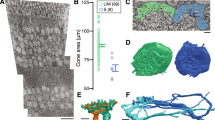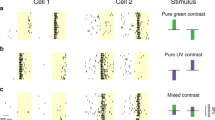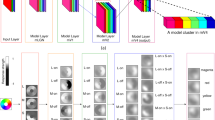Abstract
HUMAN colour vision depends on three classes of cone photoreceptors, those sensitive to short (S), medium (M) or long (L) wavelengths, and on how signals from these cones are combined by neurons in the retina and brain. Macaque monkey colour vision is similar to human, and the receptive fields of macaque visual neurons have been used as an animal model of human colour processing1. P retinal ganglion cells and parvocellular neurons are colour-selective neurons in macaque retina and lateral geniculate nucleus. Interactions between cone signals feeding into these neurons are still unclear. On the basis of experimental results with chromatic adaptation, excitatory and inhibitory inputs from L and M cones onto P cells (and parvocellular neurons) were thought to be quite specific2,3 (Fig. la). But these experiments with spatially diffuse adaptation did not rule out the 'mixed-surround' hypothesis: that there might be one cone-specific mechanism, the receptive field centre, and a surround mechanism connected to all cone types indiscriminately (Fig. le). Recent work has tended to support the mixed-surround hypothesis4–8. We report here the development of new stimuli to measure spatial maps of the linear L-, M- and S-cone inputs to test the hypothesis definitively. Our measurements contradict the mixed-surround hypothesis and imply cone specificity in both centre and surround.
This is a preview of subscription content, access via your institution
Access options
Subscribe to this journal
Receive 51 print issues and online access
$199.00 per year
only $3.90 per issue
Buy this article
- Purchase on Springer Link
- Instant access to full article PDF
Prices may be subject to local taxes which are calculated during checkout
Similar content being viewed by others
References
DeValois, R. L., Morgan, H. C., Polson, M. C., Mead, W. R. & Hull, E. M. Vision Res. 14, 53–67 (1974).
Wiesel, T. N. & Hubel, D. H. J. Neurophysiol. 29, 1115–1156 (1966).
Gouras, P. J. Physiol. 199, 533–547 (1968).
Paulus, W. & Kroger-Paulus, A. Vision Res. 23, 529–540 (1983).
Shapley, R. & Perry, V. H. Trends Neurosci. 9, 229–235 (1986).
Lennie, P., Haake, P. W. & Williams, D. R. in Computational Models of Visual Processing (eds Landy, M. S. & Movshon, J. A.) 71–82 (MIT, Cambridge. 1991).
Boycott, B. B., Hopkins, J. M. & Sperling, H. G. Proc. R. Soc. B229, 345–379 (1987).
Wassle, H., Boycott, B. B. & Rohrenbeck, J. Eur. J. Neurosci. 1, 421–435 (1991).
Sutter, E. Adv. Meth. Physiol. Syst. Modelling 1, 303–315 (Univ. Southern California, 1987).
Citron, M. C., Kroeker, J. P. & McCann, G. D. J. Neurophysiol. 46, 1161–1176 (1981).
Jones, J. P. & Palmer, L. A. J. Neurophysiol. 58, 1187–1211 (1987).
Gaska, J. P., Jacobson, L. D., Chen, H.-W. & Pollen, D. A. Soc. Neurosci. Abstr. 15, 1056 (1989).
Reid, R. C., Shapley, R. M. & Victor, J. D. Soc. Neurosci. Abstr. 15, 323 (1989).
Reid, R. C. & Shapley, R. M. Invest. Ophthalmol. Vis. Sci. 31 (suppl.), 429 (1990).
Estevez, O. & Spekreijse, H. Vision Res. 22, 681–691 (1982).
Gielen, C. C. A. M., van Gisergen, J. A. M. & Vendrik, A. J. H. Biol. Cybern. 44, 211–221 (1982).
Lee, B. B., Martin, P. R. & Valberg, A. J. Physiol. 414, 223–243 (1989).
Kaplan, E. & Shapley, R. Expl Brain Res. 55, 111–116 (1984).
Kaplan, E. & Shapley, R. M. Proc. natn. Acad. Sci. U.S.A. 83, 2755–2757 (1986).
DeMonasterio, F. M. & Gouras, P. J. Physiol. 251, 167–195 (1975).
Hubel, D. & Livingstone, M. Cold Spring Harb. Symp. quant. biol. 55, 643–649 (1991).
Boycott, B. B. & Wassle, H. Eur. J. Neurosci. 5, 1069–1088 (1991).
Milkman, N. et al. Behav. Res. Meth. Instrum. 12, 283–292 (1980).
Sutter, E. E. SIAM J. Comput. 20, 686–694 (1992).
Smith, V. C. & Pokorny, J. Vision Res. 12, 2059–2071 (1972).
Author information
Authors and Affiliations
Rights and permissions
About this article
Cite this article
Reid, R., Shapley, R. Spatial structure of cone inputs to receptive fields in primate lateral geniculate nucleus. Nature 356, 716–718 (1992). https://doi.org/10.1038/356716a0
Received:
Accepted:
Issue Date:
DOI: https://doi.org/10.1038/356716a0
This article is cited by
-
Neuronal Representation of Ultraviolet Visual Stimuli in Mouse Primary Visual Cortex
Scientific Reports (2015)
-
Single cell spectrally opposed responses: opponent colours or complementary colours?
Journal of Optics (2013)
-
Sex and vision II: color appearance of monochromatic lights
Biology of Sex Differences (2012)
-
Functional connectivity in the retina at the resolution of photoreceptors
Nature (2010)
-
Theoretical analysis of reverse-time correlation for idealized orientation tuning dynamics
Journal of Computational Neuroscience (2008)
Comments
By submitting a comment you agree to abide by our Terms and Community Guidelines. If you find something abusive or that does not comply with our terms or guidelines please flag it as inappropriate.



